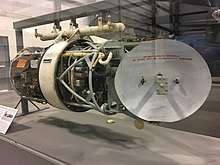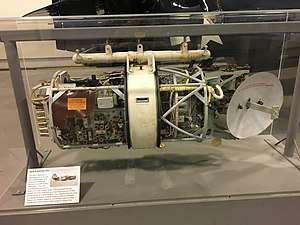AN/APS-4
The AN/APS-4, originally known as ASH (air-surface, model H) is an early military air to air and air to surface radar used by American and British warplanes during World War II.
 | |
| Country of origin | UK |
|---|---|
| Introduced | 1943 |
| Type | Sea-surface search |
| Frequency | 3300 ±50 MHz (S-band) |
| PRF | 660 pps |
| Beamwidth | ~10º horizontal, ~15º vertical |
| Pulsewidth | 1 μs |
| RPM | 60 rpm |
| Range | 1 to 100 mi (1.6–160.9 km) |
| Diameter | 28 in (0.71 m) |
| Azimuth | 320º |
| Precision | ~5º |
| Power | 40 kW |
| Other Names | ASH |
| Related | AN/APS-5, AN/APS-6 |

APS-4 operated in the X band at 3 cm, compared to the10 cm S band used by most radars of the era. This allowed the antenna to be greatly reduced in size and the unit as a whole to fit into a single streamlined fairing that could be mounted to many aircraft.
In American service it was used on many aircraft, including the Douglas C-47 Skytrain, North American P-82D/F/H Twin Mustang, Vought F4U-2\5N Corsair, Grumman F6F-3/5 Hellcat, Curtiss SB2C-5 Helldiver and Grumman TBF-3 and TBM-3S Avenger.
In RAF service it was known as ASV Mark IX and equipped a number of aircraft including the Fairey Firefly, Fairey Barracuda, de Havilland Mosquito and a small number of Grumman Avengers.
Design
APS-4 radar is a lightweight air to air and air to surface radar with a detection range for large ships of about 15 miles (24 km), and about 5 miles (8.0 km) against aircraft. It could also detect coastline at approximately 75 miles (121 km).[1]
Physically, the APS-4 consists of a control box, one or two indicators, the same number of indicator-amplifiers, an antenna, a transmitter-receiver, and a cable junction box.[2] The antenna and transmitter-receiver were typically housed externally below one wing, in a fiberglass shape that was similar to a Mk 17 500 pound bomb.[3] These displays could be set for ranges of 4, 20, 50, and 100 nautical miles (6, 30, 80, and 160 km).[4] The radar weighed 180 pounds (82 kg).[4]
The APS-4 broadcast in the X-band with a wavelength of 3 cm.[4][2] Peak broadcast power varied from 40 to 70 kW according to radar version. Pulse repetition frequency was adjustable by the operator to either 600 or 1000 pulses per second. [5]
The APS-4 emitted a radio beam in the form of a 6° cone. The beam could be directed in three modes, manual, search and intercept. In manual mode the beam was aimed by operator control from 10° above, to 30° below the longitudinal axis of the aircraft. In search mode, the radar beam scans through 150° in azimuth, and while doing so would run two lines scans, each separated by 4°. This caused the beam to cover 10° in a vertical plane. In intercept mode, the beam executes a four-line scan, with 6° between lines, to cover a vertical plane of 24°.[3] Results were displayed on one or two 3-inch displays.[2]
An improved version was called the AN/APS-5. A simplified version for single-seat fighters was called the APS-6.[6]
References
- http://pwencycl.kgbudge.com/A/s/ASH_airborne_radar.htm>
- "HyperWar: Tactical Uses of Radar in Aircraft (RADTWOA) [Part II]". www.ibiblio.org.
- https://www.aef.se/Avionik/PDF-filer/PS18_USN_APS-4_Tactical_use.pdf
- Budge, Kent G. "The Pacific War Online Encyclopedia: ASH Airborne Radar". pwencycl.kgbudge.com.
- "Duxford Radio Society: Restoration: Radar APS-4". www.duxfordradiosociety.org.
- Budge, Kent G. "The Pacific War Online Encyclopedia: APS-6 Airborne Radar". pwencycl.kgbudge.com.